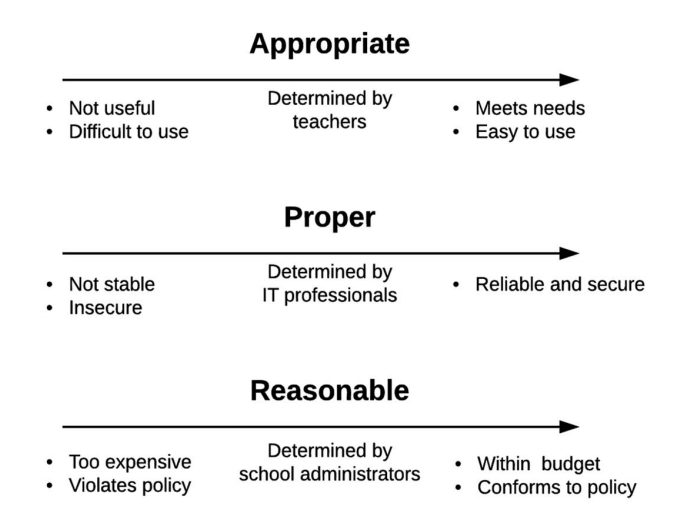1.2: Efficacious IT Management
- Page ID
- 5623
Within any organization, leaders define a small number of strategic goals; these indicate the conditions they seek to make true and the success of the organization is determined by the degree to which these goals are accomplished. When an organization achieves its strategic goals, we recognize the leaders and members have been efficacious. Throughout this book, I refer to “efficacious IT managers” which is a group comprising teachers, IT professionals, and school leaders whose decisions and actions lead to the strategic goals being realized
Each community defines its own strategic goals, but I fully expect every reader of this book is associated with (or hopes to become associated with) a school in which leaders have articulated a strategic goal such as “Students will fully participate in the communication life of our society which is dominated by digital information technologies.” (My choice of words models John Dewey, who is credited with saying “Education is not preparation for life; education is life itself.” Therefore, the strategic goal is written to participate in the information life of society, not simply to prepare students for it.)
This book was written to support school professionals (educators, technicians, and leaders) as they become efficacious IT managers. It concerns both the decisions they make and the actions they take to ensure the information technology infrastructure installed in schools is useful to teachers as they work with learners as they become citizens in the emerging digital world. This book is intended to help IT professionals understand the world of education and for educators to understand the world of IT.
Because strategic goals are generally too broad to guide meaningful action, planners define logistic goals. In situations where the logistic goals are aligned with the strategic goal, there will exist a positive association between achieving the logistic goals and achieving the strategic goal. With regards to information technology in schools, logistic goals must ensure decisions are made and actions taken to create technology that is appropriate, proper, and reasonable (see figure 1).
• Teachers (whose who spend their days working directly with students) steer decision-making processes so that IT systems are appropriately configured to be useful for the curriculum they teach, the pedagogical methods they employ, and the developmental circumstances of their students.
• IT professionals implement decisions so that IT systems are properly configured; this ensures the IT is operational, it functions as expected, and it is secure.
• School administrators govern decision making to ensure IT systems are reasonably configured and supported to meet the needs of learners and to reflect local priorities and limits. Reasonableness is a relative term and it is defined locally; budgets, existing policy and procedure, and similar factors affect what is deemed reasonable.
A situation I encountered when writing an early draft of this book serves to illustrate how proper, appropriate, and reasonable

Figure \(\PageIndex{1}\): Dimensions of efficacious IT management
configurations of IT can influence teaching and learning. I was asked to help resolve some “network problems” in a school. Math teachers had complained that students could not access the online grade book from the computers provided under the recently begun one-to-one initiative. It turned out the network administrator had configured the permissions and switching so that students were unable to access the online grade book while at school. He reasoned, “We need to prevent students from trying to ‘hack’ their grades.” The principal responded, “That seems an insignificant threat, and it prevents students from tracking their grades when they are here at school. It is essential they be able to see their grades while in class with their teachers present” and he directed the network administrator to reconfigure the network. In this case, the network administrator properly configured the network (he had successfully prevented students from accessing the server), but the configuration was inappropriate (it prevented access to information necessary for teaching and learning), and it was deemed unreasonable (thus the school administrator who had authority insisted the configuration be changed).



